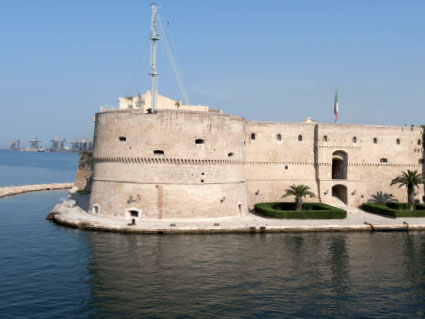





The Confraternity of SS. Maria Addolorata and San Domenico founded its origins in the liturgical and popular traditions first from the Order of Preachers and later from the spirituality of Maria’s Servants.
The Dominican Fathers established their convent in Taranto from 1315 onward, in the old town, in the Abbey of S Pietro Imperiale, held once by the Benedictine fathers, and known as San Domenico Maggiore only in the second half of 19th century: they operated for a long time until the late 19th century, after the Unity of Italy.
The Dominican Fathers founded two laic confraternities in order to celebrate the triumph of Christianity against the Turks in the Lapanto battle (7th October 1571): the former called “Il Nome di Dio” (1580( and the later “Il Rosario” (1615). One century later in 1670 the Preachers founded a third confraternity called “San Domenico di Soriano” and devoted to their Patriarch. The date of foundation was on 24th April 1777, the day when they obtained the royal assent from Ferdinand IV, King of Two Sicilies. The new Confraternity hosted the Provincial Chapter of Dominican Fathers on 30th April 1758. At the same time also the devotional congregations addressed to Our Virgin of Sorrows started to spread.
Although there are no more documents due to the collapse of the roof of the Church during the Christmas night in 1964, many believe that some Servant Fathers predicated in the province of Taranto, as witnessed by an oil painting that portrays Our Virgin of Sorrows and Seven Saints founders of the order of Servants of Mary. The adoration of the Virgin was strengthened after the building of the statue of the Virgin (now kept by the Confraternity) in the second half of 17th century in Naples by an unknown author in the same period of the building the statue of St. Dominco, commissioned by the Dominican Fathers. .
The latter was placed in the chapel dedicated to St. Domenico, while the former was collocated in the Church of San Giovanni Battista (today destroyed) and preserved by the Benedictine nuns.
On Holy Friday during the Holy week and on the third Sunday in September the statue of the Virgin was carried in private procession for the feast of “Triumph of the Seven Sorrows”.
This last ceremony had been authorized by the Saint Siege in 1668 and was later extended to Spain in 1735 by Filippo V and lastly to all Catholic Church by Pio VII.
Thanks to the mission of the abbot Vincenzo Cosa, the Spiritual Father of the Confraternity, who introduced in 1735 the practice of the Devotion of the Seven Sorrows in the chapel of S. Domenico, there was a growing devotion among people.
Later, due to the shortage of nuns, Vincenzo Cosa was obliged to stipulate an Act of Donation on 15 May 1795, by which the statue of the Virgin and the money of the confraternity were left to the brothers of the same fellowship.
On 21st February 1794 the Feast of Our Lady of Sorrows was granted the Royal assent and in 1870 the Archbishop of Taranto, Mons Giuseppe Rotondo, officially founded the confraternity.
Since that moment the confraternity adopted its own statute which regulates the management of the funds and incomes used to organize all the ceremonies and especially the rites of the Holy Thursday and Good Friday.

The Confraternity of Carmine was officially founded on 10th August 1675 by a decree signed by the Archibishop of Taranto, Mons. Tommaso F. Sarria O.P. As reported in some documents, the confraternity had existed since 1577, when the Carmelite community moved to the extra moenia Church of Madonna della Pace, called church of Misericordia. In 1765 the Calò family donated the statues of Dead Christ and Our Virigin of Sorrows to the Confraternity.
Don Diego Calò, indeed, had commissioned these two statues to a sculptor from Naples and every Holy Friday these were carried in a private procession. Then they were donated to the Confraternity: the only request advanced by members of the Calò family was to be allowed to take part to the religious procession by holding the laces of Jesus Christ’s coffin. The Confraternity accepted and few years later other six statues were added.
The first statutes of the confraternity were inspired to the principles of the Gospels and granted the privilege of enter first during the visit to the Sepulchres.
In 1806 due to the arrival in Taranto of the French troops led by Napoleon, the convent was suppressed and used as a deposit for weapons and a shelter for the numerous soldiers sent by the French Emperor.
The church was closed and the Confraternity joined the Confraternity of SS. Trinità until 1810 when it went back to its original place.
On 16 march 1875, Pope Pio X granted the brothers the same privileges of those who went in pilgrimage to the seven churches of Alma Roma. Such privilege was renewed by Pope Leone XIII first and later by Pio X. Today the Confraternity is ruled by the statute of all theconfraternities of the Arcidiocesi approved in 1998 and counts 1800 members.